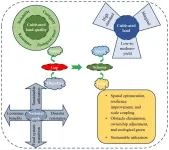(Press-News.org) HERNDON, Va., July 10, 2024 -- One of the privileges the wealthiest Americans enjoy is living wherever they want. But new research published in Risk Analysis suggests they should be cautious when choosing their Shangri-La.
In their nationwide analysis, Rutgers University geographers Michael Greenberg and Dona Schneider compared the concentration of hazards and associated risks impacting the richest and poorest counties and the richest and poorest municipalities in all 50 states (200 locations).
When they compared their results to the national averages for each risk, they found that residents of America’s wealthiest communities face higher economic consequences from natural hazard events (like hurricanes and drought) and exposure to air pollution compared to the poorest, mostly rural communities. People living in the lowest-income municipalities have lower economic consequences from natural hazards, but at least 50 percent higher suicide rates, homicide rates, and firearm fatalities compared to the national average.
The purpose of the study, says Greenberg, was to illustrate that “relationships between income and the geography of hazards and risks are not that simple. Low-income areas are burdened by many hazards, yet even the most affluent suburban residents cannot escape the hazards of living near industrial and waste management facilities.”
One of the metrics included in the analysis was the National Risk Index -- a FEMA tool that shows which communities are most at risk of specific natural hazards. For the wealthiest communities included in the study, the data revealed that seven of the 10 highest natural hazard risk places are in California. The three others are Houston, Texas; Huntsville, Alabama; and Oklahoma City, Oklahoma. (All three are subject to earthquakes, fires, floods, and tornados). “The wealthiest people often choose to live in places that are dangerous due to natural hazards,” says Greenberg. One example is coastal southern California, where some of the richest neighborhoods are susceptible to drought, wildfires, flooding, and landslides.
A hazard is something that has the potential to harm humans or the environment. Risk (expressed as a probability) is the likelihood of a hazard causing harm. In addition to natural hazards, other risk metrics included in the analysis are anthropogenic hazards like air pollution and toxic waste sites; health-related risks like homicide and suicide rates, low life expectancy, and percentage of smokers; and social assets like food security and access to exercise and health care.
Here are some of the study’s most significant findings…
People living in the highest-income communities:
are more likely to experience and face higher economic losses from natural hazards (such as hurricanes, drought, and tornados) because they have more assets to lose.
reside in more densely populated urban-suburban areas and are more likely to live near higher concentrations of anthropogenic hazards (hazardous waste and Superfund sites, heavy traffic arteries, and air pollution).
have better access to high-quality medical care, the best educational opportunities and entertainment venues, as well as rapid communication and other desirable assets.
People living in the lowest-income communities:
have fewer assets to lose but have a much more limited response capacity in the event of a disaster.
have lower exposure to anthropogenic hazards like dense motor traffic, air pollution, and hazardous waste sites than the nationwide averages (for municipalities). They are mostly in rural locations and have a lower exposure to dense motor traffic and other hazards associated with urban life compared to high-income communities.
have much higher social vulnerability and are more likely to struggle to secure access to information, as well as the expertise and services that protect them from risks.
have at least 50 percent higher suicide and homicide rates, and other firearm fatalities, as well as percentage of current smokers in their populations compared to the national average.
are disproportionately less likely to have ready access to health services (like primary care doctors), suffering worse outcomes for morbidity and mortality -- with lower life expectancy rates
are at a nearly 40 percent higher risk for lack of educational achievement compared to the highest-income counties (measured by rates of high-school graduation).
How to Learn About Where You Live
Greenberg points out that if people want to understand more about their community’s risks, they can turn to the same free databases used in the study – for example, the EPA’s EJScreen. There, users can find demographic, social, economic, and air quality information, as well as the location of potential industrial and waste management hazards for their communities. “You can put a circle around your house and find out all kinds of information,” says Greenberg. “Why not educate yourself?”
Demographics of Richest vs. Poorest
To highlight the geographic effects of income disparity, the study includes a brief demographic comparison of these richest and poorest municipalities in four states: California (Atherton vs. Mecca), North Carolina (Marvin vs. Enfield), New York (Scarsdale vs. New Square), and Ohio (Indian Hill and East Cleveland). As an example, affluent Marvin and impoverished Enfield are located 260 miles apart. Marvin is a suburb of Charlotte while Enfield borders South Carolina. Marvin’s population is over 85 percent non-Hispanic white while Enfield’s is 85 percent African American. The public school system in Marvin is rated A+ while Enfield’s is rated D. “Marvin represents growing affluence and Enfield represents an overlooked poor African American community,” says Greenberg.
He and Schneider hope their risk analysis will provide a useful perspective to government officials choosing where to allocate funds available via the Justice40 program and others meant to provide resources to America’s poorest and most underserved communities.
###
About SRA
The Society for Risk Analysis is a multidisciplinary, interdisciplinary, scholarly, international society that provides an open forum for all those interested in risk analysis. SRA was established in 1980. Since 1982, it has continuously published Risk Analysis: An International Journal, the leading scholarly journal in the field. For more information, visit www.sra.org.
END
Does living in America’s wealthiest communities make you safer?
2024-07-10
ELSE PRESS RELEASES FROM THIS DATE:
Spectacular auroras are caused by head-on blows to Earth’s magnetic field that could damage critical infrastructure
2024-07-10
Auroras have inspired myths and portents for millennia — but only now, with modern technology dependent on electricity, are we appreciating their true power. The same forces which cause auroras also cause currents that can damage infrastructure which conducts electricity, like pipelines. Now scientists writing in Frontiers in Astronomy and Space Sciences have demonstrated that the impact angle of interplanetary shocks is key to the currents’ strength, offering an opportunity to forecast dangerous shocks and shield critical infrastructure.
“Auroras and geomagnetically induced currents are ...
An approach for robust facial attribute classification
2024-07-10
Face attribute classification (FAC) is a high-profile problem in biometric verification and face retrieval. Although recent research has been devoted to extracting more delicate image attribute features and exploiting the inter-attribute correlations, significant challenges still remain.
To solve the problems, a research team led by Na LIU published their new research on 15 June 2024 in Frontiers of Computer Science co-published by Higher Education Press and Springer Nature.
The team proposed a scattering-based hybrid block, termed WS-SE, to incorporate frequency-domain (WST) and image-domain (CNN) features in a channel attention manner. Compared with CNN, WS-SE achieved ...
Risky drinkers most at risk: Ads from sports broadcasts significantly increase alcohol urges
2024-07-10
10 July 2024
Risky drinkers most at risk: Ads from sports broadcasts significantly increase alcohol urges
New Edith Cowan University (ECU) research shows exposure to alcohol advertisements during national sports broadcasts, particularly those that feature a preferred beverage, significantly increases cravings in people with risky drinking behaviours.
The ECU study, led by Dr Ross Hollett, analysed nationally televised finals matches from the Australian Football League (AFL) and the National Rugby League (NRL) ...
How to differentially improve the cultivated land quality in China?
2024-07-10
Quality is the core characteristic of cultivated land and is crucial for ensuring sustainable resource utilization and national food security. To meet the increasing demand for food driven by rapid population growth and the continual optimization of dietary structures, the intensity of cultivated land utilization has been steadily increasing. This trend has resulted in degradation issues such as deterioration of black soil, thinning of the cultivated land layer, reduction in organic matter content, soil salinization, acidification, and contamination by heavy metals, all of which threaten national food security. Currently, China has entered a critical period of agricultural ...
Study reveals racial disparities in Huntington’s disease diagnoses
2024-07-10
New research led by UCLA Health revealed that Black patients with Huntington's disease in the U.S. and Canada received their diagnoses, on average, one year later compared to White patients after symptoms first appear.
Huntington’s disease is a rare, incurable genetic disease that causes a gradual death of nerve cells, resulting in a variety of symptoms affecting movement, emotions and cognition. About 41,000 Americans have the disease and 200,000 are at risk of inheriting it, according to the Huntington’s Disease Society of America. Children of a parent with ...
Archaeologists report earliest evidence for plant farming in east Africa
2024-07-10
A trove of ancient plant remains excavated in Kenya helps explain the history of plant farming in equatorial eastern Africa, a region long thought to be important for early farming but where scant evidence from actual physical crops has been previously uncovered.
In a new study published July 10 in the Proceedings of the Royal Society B, archaeologists from Washington University in St. Louis, the University of Pittsburgh and their colleagues report the largest and most extensively dated archaeobotanical record from interior east Africa.
Up until now, scientists have ...
UQ research reveals exercise brain boost can last for years
2024-07-10
A longitudinal study by University of Queensland researchers has found high-intensity interval exercise improves brain function in older adults for up to 5 years.
Emeritus Professor Perry Bartlett and Dr Daniel Blackmore from UQ’s Queensland Brain Institute led the study in which volunteers did physical exercise and had brain scans.
Emeritus Professor Perry Bartlett and Dr Daniel Blackmore have shown high intensity exercise boosts cognition in healthy older adults and the improvement was retained for up to 5 years.
Emeritus Professor Bartlett said it is the first ...
Researchers identify brain region involved in oxycodone relapse
2024-07-10
LA JOLLA, CA—Even years after they have recovered, a person who once struggled with alcohol or opioid addiction can relapse—and that relapse is more likely to occur during particularly stressful times. Now, Scripps Research scientists have identified an area of the brain that plays a key role in stress-induced oxycodone relapse. Their findings explain why the drug suvorexant, which they previously found to reduce alcohol and oxycodone relapse when administered orally, works so well.
“Having a better understanding of the region(s) in the brain responsible for this kind of relapse is incredibly important as we develop treatments for alcohol use disorder and opioid ...
Daily sugar intake fell by 5 g in kids + 11 g in adults year after UK sugar tax imposition
2024-07-10
Daily sugar intake fell by around 5 g in children and by around 11 g in adults in the 12 months following the introduction of the UK’s ‘sugar tax’, formally known as the Soft Drinks Industry Levy, finds an analysis of 11 years of survey data, published online in the Journal of Epidemiology & Community Health.
The sugar from soft drinks alone made up over half this total, the estimates suggest. But overall daily energy intake from free sugars levels are still higher than the updated recommendation from the World Health Organisation (WHO) of 5%---equivalent to 30 g/day for adults, 24 g for 7–10 year olds, and 19 g for 4–6 year olds—point ...
Osteoarthritis may double risk of speedy progression to severe multimorbidity
2024-07-10
Osteoarthritis—a condition in which the protective cartilage on the ends of bones breaks down—may more than double the risk of speedy progression to accumulating severe long term conditions (multimorbidity), finds a 20 year study published in the open access journal RMD Open.
And there seem to be 4 different speeds of progression to multimorbidity, the findings indicate.
Persistently low levels of physical activity, a high calorie diet, plus chronic low grade inflammation may help to explain the link between osteoarthritis and the risk of accumulating other long term conditions, suggest the researchers.
Although the exact causes aren’t known, injury, age, family ...



